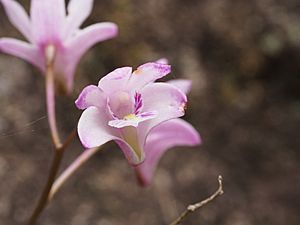Pink rock orchid facts for kids
Quick facts for kids Pink rock orchid |
|
|---|---|
 |
|
| Dendrobium kingianum flower detail | |
| Scientific classification | |
| Synonyms | |
|
The pink rock orchid (scientific name: Dendrobium kingianum) is a beautiful flowering plant. It belongs to the orchid family. This special orchid only grows in eastern Australia. You can usually find it growing on rocks. Sometimes, it also grows on other plants or even in the ground.
This orchid has thin leaves that spread out. It also grows spikes with up to fifteen flowers. These flowers are usually pink. They bloom from late winter to spring. Many people in Australia love to grow this orchid in their gardens. It is a very popular plant among orchid growers.
Contents
What Does the Pink Rock Orchid Look Like?
The pink rock orchid often grows on rocks. It can also grow on other plants. Sometimes, it even grows in the soil. In nature, you can find it on big rocks or in cracks. It likes open forests or areas near forest creeks. You might also see it on cliff faces.
This orchid can grow alone. But it can also form large groups. These groups can spread out several meters wide. Its roots are white and spongy. This helps the plant quickly soak up water from wet rocks. The roots also reflect light. This keeps the plant from getting too hot. It helps during long dry periods.
The stems of the orchid are called pseudobulbs. They can stand straight up or spread out. These pseudobulbs are thick and juicy. They store water for the plant. This is very helpful during dry times. The roots grow from the thicker bottom part of the pseudobulb. The pseudobulb gets thinner towards the top.
Pseudobulbs are about 5 to 30 centimeters (2 to 12 inches) long. They are also about 1 to 2.5 centimeters (0.4 to 1 inch) wide. Each pseudobulb has three to six leaves near its top. The leaves are thin and smooth. They are green and folded down the middle. They are shaped like a narrow egg. The leaves are about 3 to 10 centimeters (1.2 to 4 inches) long. They are also about 10 to 20 millimeters (0.4 to 0.8 inches) wide.
The Flowers of the Pink Rock Orchid
The flowers grow on a stem called a raceme. This stem is about 7 to 15 centimeters (3 to 6 inches) long. It holds between two and fifteen flowers. The sepals and petals are usually pink. But they can also be pure white or dark purple. Sometimes, they are other colors in between.
The top sepal is about 9 to 16 millimeters (0.35 to 0.63 inches) long. It is about 4 to 7 millimeters (0.16 to 0.28 inches) wide. The labellum is about 8 to 15 millimeters (0.3 to 0.6 inches) long. It is also about 7 to 12 millimeters (0.28 to 0.47 inches) wide. The labellum usually has dark purple marks.
Most flowers bloom from August to October. This is late winter to mid-spring in Australia. But they can bloom earlier or later. This depends on the weather.
Where Does the Pink Rock Orchid Grow?
The pink rock orchid grows in eastern Australia. You can find it from the coast to nearby mountain ranges. Its range is between the Hunter River in New South Wales and Rockhampton in Queensland. It usually grows on rocks in forests and woodlands.
Growing Pink Rock Orchids at Home
The pink rock orchid is a popular plant for growing at home. It is quite easy to care for. You can grow it on bark or attach it to a rock. You can also plant it in a pot. If you use a pot, make sure the soil drains water quickly. A mix of coarse bark and river pebbles works well.
This orchid grows best in a warm, sunny spot. It likes a lot of moisture in the air. This is especially true during its growing season. This season is from August to March. The pink rock orchid is used to dry winters in Australia. It flowers best after a dry period.
You can buy these orchids from special nurseries. But it is against the law to pick them from the wild. This rule helps protect native plants.
Images for kids
-
D. kingianum growing near Coffs Harbour






